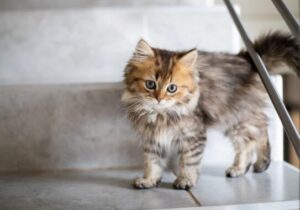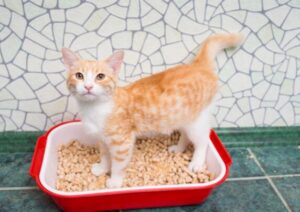The most challenging part of keeping a cat is cleaning the litter box. Felines love to live in clean environments to avoid parasitic infections. However, even the most hygienic cats will use their facilities, and improper handling of this waste may compromise human health. There are various ways to handle the trash, each with its merits and demerits. If you are wondering what to do with used kitty litter, here are some useful solutions.
Table of Contents
What To Do With Used Kitty Litter?

Scoop Out The Waste
The most common way to remove a cat’s waste out of the litter box is by scooping. Use the scoop to take out urine and stool clumps and put them in a trash bag. Once you finish, tie it tightly then place it in a trash bin, with a fitting lid.
It would be wise to use a separate trash bag for your kitty’s litters for hygiene purposes. It makes it easier for the waste collectors to segregate the garbage correctly, eliminating those that can harm humans and the environment.
Use heavy-duty trash bags like the clay cat litters to avoid creating messes or combine two thin ones. Moreover, it would be best to get rid of the trash immediately after collection to avoid awful smells and prevent bacteria leaks.
Wear gloves when handling cat waste and a mask, especially when dealing with clay litters since they can produce harmful dust. The most common types of garbage that you can eliminate using this method include silica, clay clumping, and recycles newspaper cat litters.
Recommended trash bags for cat litters
Bury The Waste
If you have sufficient space in your garden, burying is the most viable way to eliminate kitty waste. To accomplish this, ensure that you bury the litter at about one foot under the surface and then cover it with a large stuck of dirt at least eight inches. Sufficient covering also helps conceal the awful smell and prevents anyone from falling.
Alternatively, you can buy a cat waste composter, purpose-made bins, placed in a dug pit. It creates a tidier option rather than having to dig a hole in your garden. Once you collect the litter, you open the lid, place the waste, and close the bin.
You need to abandon your hole after every three to four months then dig a new one. The aim is to give the waste sufficient time to break down and enrich your garden’s soil. Beware that this method may not work well if you have aggressive dogs with a powerful sense of smell that likes to dig around.
Recycle By Compositing
Read through the litter components before purchase and pick one made with natural materials. If it contains corn, wheat, chicken feed, or any other food byproducts, you can composite it. You shouldn’t include silica crystal or clay-based litters in your composite, since they won’t break down.
Rather than dumping the wastes into a trash bin, throw them into a composite pit to turn them into fertilizers. It’s an eco-friendly alternative that helps minimize the amount of garbage in landfills. Additionally, you acquire natural manure for your gardens, so you refrain from chemical fertilizers.
You can do it in an old bucket or a specialized composting bin, which will save you the hustle of turning the composite materials with a stick. If you have more space, do the in-ground compositing. It can handle a large volume of waste at the same time.
Ensure that the composting site isn’t near any water source or kitchen garden. It’s worth noting that you can only use the composite manure for your flower gardens or some trees. Note that cat waste contains bacteria and parasites that can infect other animals and humans. Therefore, you should never use it on any edible plant.
Use Biodegradable Bags To Dispose Of The Litter
The easiest method to handle your kitty waste is by using a biodegradable trash bag. You collect the soiled litter, Put it into the bag, and toss it into the composite without pouring out the materials. Chances are, the garbage will decompose faster. Alternatively, you can use the brown eco packaging bags, which take less time to breakdown.
Seek Poop Collection Services
Different cities or state offers some cat litter collection services, similar to garbage collectors. You can Google to confirm whether the companies offer these services near your home area. It’s worth noting that they will charge a fee for their services, and it would be wise to research the right pricing before reaching out.
Use The Cat Litter Disposal System
These are airtight containers available at pet stores for litter disposal. It’s a specialized and airtight bin, and you dump the waste directly into the can. Further, it eliminates the need to take out the trash bag very often.
Flush
Never flush clay-based litters since it can wreck your plumbing system. However, it’s okay to flush urine clumps but not stool waste. Additionally, if you reside in the coastal areas or near primary water sources, refrain from flushing cat waste. The feline litter contains harmful bacteria that may contaminate the water sources.
Nonetheless, you can flush the corn and wheat litters. Do it a few at a time instead of a whole batch to avoid clogging your pipes. Another flushable option is the pine litter since it disintegrates very quickly.

Conclusion
A responsible pet owner must know how to handle his cat’s waste appropriately. For hygiene purposes, make it a habit to remove your litter every day. It helps eliminate odors or harmful bacteria that may build up in the box. Also, make it your habit to composite and switch to biodegradable litter as much as possible.
Additionally, you can only flush your waste if it’s flushable, and you live far from water sources, but you may need to confirm with your local sewer service providers. The above guide on what to do with used kitty litter outlines various disposal methods to help you deal with the waste. Remember that there isn’t a single method that works for everyone, but you can pick your preferred option based on your kitty litter type.



